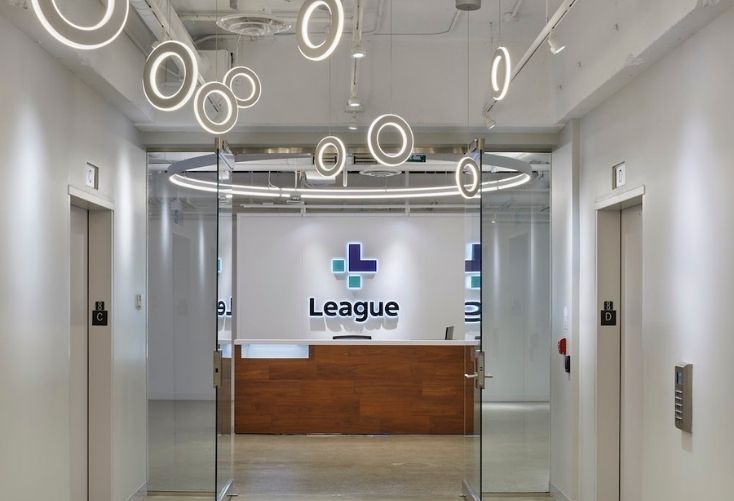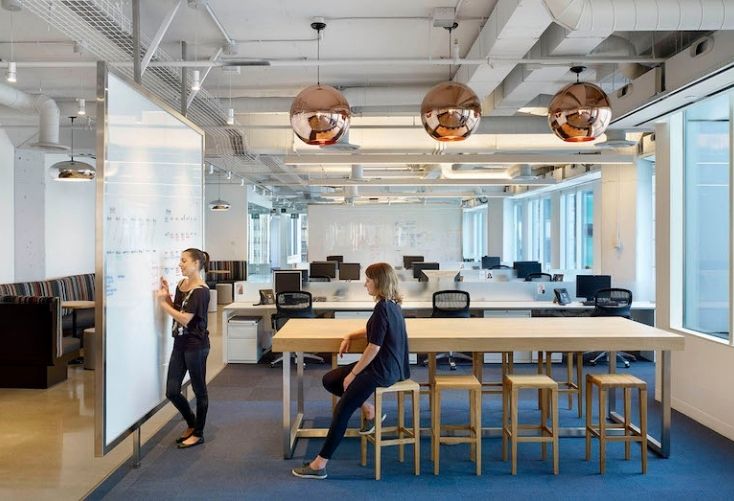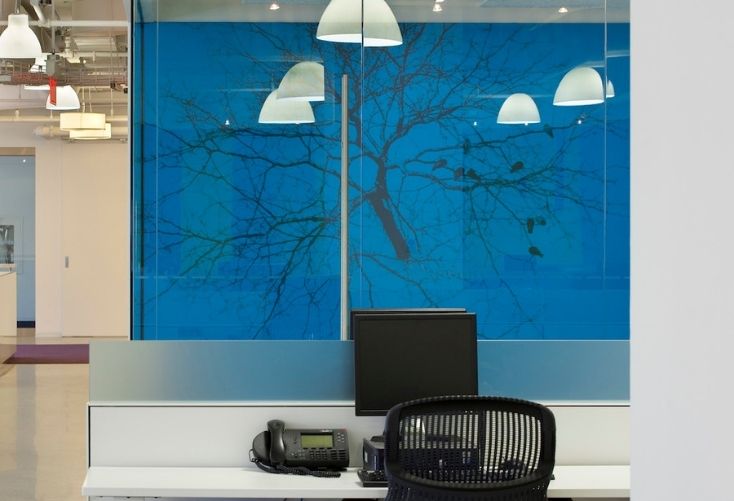- Inger Bartlett, founder and president of Bartlett & Associates, shares the key concepts influencing office design projects in the near future.
- Drawing on lessons learned from the past year, Bartlett explains why now is the perfect time to rethink workspace for the post-vaccine world.
- From workforce distribution to collaborative spaces and biophilic design, here are 10 things that designers and architects are carrying into their future work.
This article was originally published on Work Design Magazine.
What a ride the last year has been. Especially for those of us who design offices, where we will be dealing with the impacts of this pandemic for years to come. It’s clear that there is no putting the lid back on the box – an event of this magnitude is sure to be a catalyst for change, and that’s not necessarily a bad thing.
We have finally arrived at a point where things are looking up. Vaccinations are rolling out and the pace is accelerating. We’re feeling increasingly hopeful that by fall things might be a lot more like the good old days. With this exciting prospect on the horizon, it’s the perfect time to rethink workspace for the post-vaccine world.
The past year has offered many lessons which designers and architects will carry into their future work, particularly when it comes to offices. Here’s how these lessons will manifest change in the post-vaccine workspace and the top 10 concepts influencing office projects in the very near future.
1. A more distributed workforce
A new hybrid way of working will be the most visible and impactful change for companies around the globe. It’s something we’ve seen clients adopting at various scales for years, and that’s come in waves – we’ve seen companies introduce it, then find it’s not an efficient way for them to work and eventually pull it back. Others have had very successful experiments and implemented some level of remote work on a permanent basis. Now that most office workers have been forced to give WFH their best effort, there aren’t many companies that don’t have a clear idea of how well it works for them. And the real estate savings that could accompany fully remote or hybrid working profiles will be very appealing to those who have taken a financial hit as a result of the pandemic.
On the other hand, people miss working in the office together. The social aspect of work is something that this year of isolation has really highlighted, and collaborating virtually just isn’t the same. Once we are able to share space more safely, people are going to be looking to do so – albeit cautiously. There are obviously some employers currently looking at going remote entirely, but in the end it will cost them. Every employee being in the office all day, every day, might not be necessary in a lot of cases – but there is much to be lost when no one is ever together. Those in-person interactions are key to collaboration and creativity, to company loyalty and creating a sense of community.

2. Corporate culture/branding
Speaking of corporate community… the office is where corporate culture is built, period. That’s why the role of the office will become even more important as employees spend less time there. Office interiors will need to make a stronger statement for existing and potential employees, as well as clients and customers.
Workspace – and workspace designers – will need to work extra hard to create a feeling of corporate community when that community is no longer together 9 to 5, 5 days a week. It poses some interesting design challenges: Explore new ways to bridge the gap between the home and corporate offices. Make employees feel comfortable in a less familiar office. For instance, branding and graphics can carry right from an interior into employee’s homes through digital connections such as apps or virtual meeting backgrounds.

3. Collaborative space
For every company that supports hybrid work, the main reason staff will visit the office is to meet and collaborate with co-workers or clients. There will be some looking for a change of scenery from the home office, or to work closer to clients, but for the most part our time in the office will involve groups of all sizes coming together and that means a new balance of space: Less workstations and more areas to gather in. The large Town Hall spaces that are already popular in Agile Workspace will be ideal for bringing big groups together – think all staff meetings, team building exercises, staff parties and other corporate events. But we will also need to accommodate smaller groups that may need some degree of privacy. Individual companies will need to consider how their staff works together to determine the appropriate mix of large and small meeting rooms, breakout zones and touch-down spaces.
4. Sharing systems
Effective software for booking workstations and meeting rooms in the office will be key to making hybrid systems work. Without this, employees who travel from the suburbs to a downtown headquarters only to find there are no available desks will quickly become frustrated and unfocused. That goes double for those looking for a free room to meet with a client – or a group of co-workers who have also spent time travelling to the office. I’d love to tell you design can take care of everything, but in this case, nothing will run smoothly without adequate scheduling that everyone adheres to and respects, especially in larger organizations. The same software can also be used to help co-workers keep track of each other, ie. Sophie is working remotely today, but can be reached via email or the office Slack channel. The programs will also be useful for future workplace strategy and design development, as they enable employers to effortlessly track valuable data.
5. Biophilic design features
If workforces are going to successfully come back to the office to enjoy in-person collaboration, setting people at ease will be essential. All of us will be wary of shared spaces and highly conscious of proximities and cleanliness, for a long time to come.
Biophilia is already one of the most effective tools designers have for promoting a sense of well being. Creating strong connections with nature has always been central to our studio’s practice at Bartlett & Associates. We’ve heard from some of our existing clients that the links between their space and the natural world have helped them feel more comfortable during recent office visits. The scientific evidence presented to us over the last year has also taught us we are safer gathering outside than in, so physical links to nature and fresh air, ie. direct access to outdoor space, will be highly appealing.

6. Economy
Many businesses are facing big financial challenges right now and there’s no telling how the economy will take to recover. Those who have taken a hit will be first in line to embrace new remote and hybrid work programs. In turn, they will also be looking to shrink their office footprint, which means moving to a new space, or perhaps trying to sublease part of their existing space. The latter is going to be a difficult proposition – in Toronto alone downtown office vacancies rose from 2.2 to 7.2 percent since 2019. CBRE is suggesting it may reach over 12 percent by the end of the year. Offloading excess square footage will be tough, but those able to end current tenancies will have little difficulty finding a smaller, less expensive space packaged with unprecedented landlord incentives.
7. A new appreciation of personal space
Over 38 years in business we’ve seen Open Plan totally take over more and more markets – and it’s become more and more dense. In the last decade alone the average open plan office in North America has shrunk its square-feet-per-person by about a third. We’ve seen the numbers go as low as 100 square feet per person and that’s going to be hard to sell after so much time focused on keeping our distance. Even once most of the population is vaccinated, people will continue to be wary of each other and of potential illness. The next cold season when people start coughing and sniffling at work, is going to be triggering to say the least.
Not to mention the normal activity and noise of the office. We’re going to be coming out of this with renewed sensitivity to those distractions – at least for those who weren’t at home with their children. A lot of people are now used to having a quieter space to focus in. Or maybe they’ve grown accustomed to having background music on, or even to keeping their space a little warmer than those office towers with the thermostat set for men in three-piece suits.
Asking people to return to noisy, over-air-conditioned spaces where their neighbour’s coffee cup keeps creeping closer is going to be a hard sell. Take note: spacious and defined workstations, acoustic and temperature control – these factors should all be given increased attention in the post-vaccine era.

8. Increased consideration of workspace hygiene
During the pandemic we’ve seen most workspace clients opt to simply keep staff at home, rather than invest in significant alterations to their spaces. Things can change so quickly, the wait-and-see approach has felt safest. The one area where we have seen some changes that are more permanent than rearranging furniture, is on high-touch surfaces. Levered faucets have been swapped out for hands-free taps. Touchless entry has been introduced in buildings such as 5255 Yonge, a Toronto office tower for which B|A designed a new lobby in 2019. The building’s owners, Crown Realty, are also testing a new antimicrobial copper film that adheres to high-touch areas and could be a great retrofit solution for those features where contact is necessary, such as handrails.
In the future we know we’ll see even more touch-free technology, but we can also expect to see the types of seamless, durable, easy-to-maintain surfaces and finishes that we typically see in healthcare settings enter the workplace. More elegant hand sanitizer stations in areas like elevator lobbies is another area designers might turn their focus, and this is also the time to be looking at the latest innovations in HVAC/air quality.
9. Wider embrace of technology
A lot of office workers had to get out of their comfort zone with technology in the last year. Workers who were used to having tech support on hand every day were sent home with computers they’d never set up on their own. People who had never even heard of Zoom were suddenly using it multiple times a day. That newfound tech savvy is coming back to the office with us. On one side of that will be expectations: our distributed workforces will need office areas geared specifically towards virtual meetings. Those workers who were previously using desktop computers will likely replace them with more portable laptops, and that will change workstation requirements.
Amidst all this change, this is the perfect time to introduce tech upgrades that can help employers and employees alike. For instance, apps for the previously mentioned reservation systems, or even the contactless entry to buildings.

10. Preparedness for future disruption
We’re all aware that another pandemic could be in our future. Many experts say we can count on it. Should it happen, no one wants to be as unprepared as most of the world found itself this time around. As much as we are ready to move on and get back to normal, it will be prudent to take the lessons of this situation into our future workspaces in order to build resilience.
As designers we can help our clients build resiliency and adaptability into their businesses with flexible spaces and furnishings – and flexible workplace strategies to match. The future won’t look so different from the Agile Offices that are already popular – we’ll just need to design them to adapt more readily, in as many ways as possible. Workstations that can easily be moved or reconfigured to meet changing appetites for work from home. Modular partitions to allow that balance of collaborative space and heads-down space to shift on a dime. Zones and furniture that work equally well for focused and collaborative work. If there’s anything the past twelve months have taught us, it’s the value of adaptability.


 Dr. Gleb Tsipursky – The Office Whisperer
Dr. Gleb Tsipursky – The Office Whisperer Nirit Cohen – WorkFutures
Nirit Cohen – WorkFutures Angela Howard – Culture Expert
Angela Howard – Culture Expert Drew Jones – Design & Innovation
Drew Jones – Design & Innovation Jonathan Price – CRE & Flex Expert
Jonathan Price – CRE & Flex Expert













